Haonan Dong
Meta-R1: Empowering Large Reasoning Models with Metacognition
Aug 24, 2025Abstract:Large Reasoning Models (LRMs) demonstrate remarkable capabilities on complex tasks, exhibiting emergent, human-like thinking patterns. Despite their advances, we identify a fundamental limitation: current LRMs lack a dedicated meta-level cognitive system-an essential faculty in human cognition that enables "thinking about thinking". This absence leaves their emergent abilities uncontrollable (non-adaptive reasoning), unreliable (intermediate error), and inflexible (lack of a clear methodology). To address this gap, we introduce Meta-R1, a systematic and generic framework that endows LRMs with explicit metacognitive capabilities. Drawing on principles from cognitive science, Meta-R1 decomposes the reasoning process into distinct object-level and meta-level components, orchestrating proactive planning, online regulation, and adaptive early stopping within a cascaded framework. Experiments on three challenging benchmarks and against eight competitive baselines demonstrate that Meta-R1 is: (I) high-performing, surpassing state-of-the-art methods by up to 27.3%; (II) token-efficient, reducing token consumption to 15.7% ~ 32.7% and improving efficiency by up to 14.8% when compared to its vanilla counterparts; and (III) transferable, maintaining robust performance across datasets and model backbones.
AuroRA: Breaking Low-Rank Bottleneck of LoRA with Nonlinear Mapping
May 24, 2025Abstract:Low-Rank Adaptation (LoRA) is a widely adopted parameter-efficient fine-tuning (PEFT) method validated across NLP and CV domains. However, LoRA faces an inherent low-rank bottleneck: narrowing its performance gap with full finetuning requires increasing the rank of its parameter matrix, resulting in significant parameter overhead. Recent linear LoRA variants have attempted to enhance expressiveness by introducing additional linear mappings; however, their composition remains inherently linear and fails to fundamentally improve LoRA's representational capacity. To address this limitation, we propose AuroRA, which incorporates an Adaptive Nonlinear Layer (ANL) between two linear projectors to capture fixed and learnable nonlinearities. This combination forms an MLP-like structure with a compressed rank, enabling flexible and precise approximation of diverse target functions while theoretically guaranteeing lower approximation errors and bounded gradients. Extensive experiments on 22 datasets and 6 pretrained models demonstrate that AuroRA: (I) not only matches or surpasses full fine-tuning performance with only 6.18% ~ 25% of LoRA's parameters but also (II) outperforms state-of-the-art PEFT methods by up to 10.88% in both NLP and CV tasks, and (III) exhibits robust performance across various rank configurations.
GDeR: Safeguarding Efficiency, Balancing, and Robustness via Prototypical Graph Pruning
Oct 17, 2024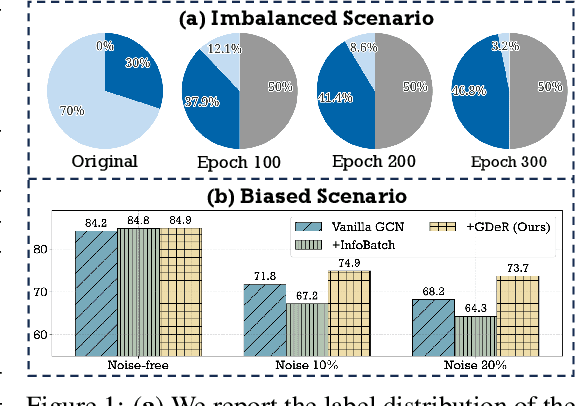
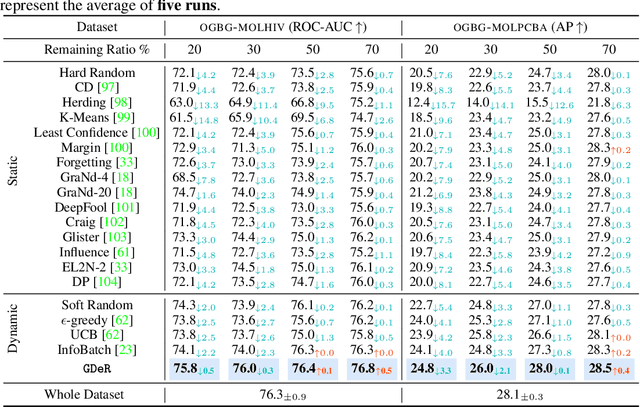
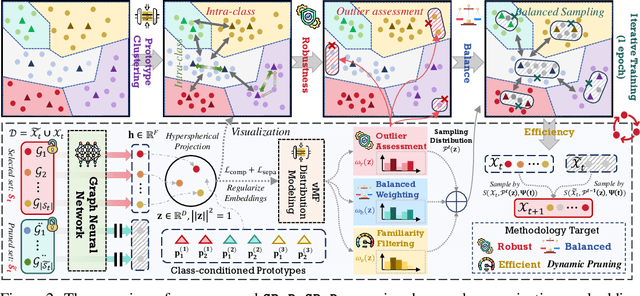
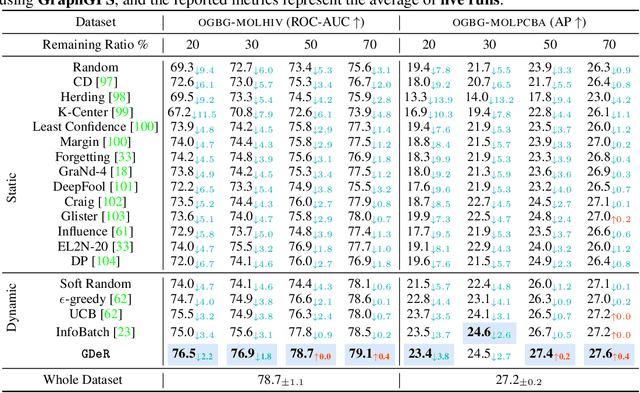
Abstract:Training high-quality deep models necessitates vast amounts of data, resulting in overwhelming computational and memory demands. Recently, data pruning, distillation, and coreset selection have been developed to streamline data volume by retaining, synthesizing, or selecting a small yet informative subset from the full set. Among these methods, data pruning incurs the least additional training cost and offers the most practical acceleration benefits. However, it is the most vulnerable, often suffering significant performance degradation with imbalanced or biased data schema, thus raising concerns about its accuracy and reliability in on-device deployment. Therefore, there is a looming need for a new data pruning paradigm that maintains the efficiency of previous practices while ensuring balance and robustness. Unlike the fields of computer vision and natural language processing, where mature solutions have been developed to address these issues, graph neural networks (GNNs) continue to struggle with increasingly large-scale, imbalanced, and noisy datasets, lacking a unified dataset pruning solution. To achieve this, we introduce a novel dynamic soft-pruning method, GDeR, designed to update the training ``basket'' during the process using trainable prototypes. GDeR first constructs a well-modeled graph embedding hypersphere and then samples \textit{representative, balanced, and unbiased subsets} from this embedding space, which achieves the goal we called Graph Training Debugging. Extensive experiments on five datasets across three GNN backbones, demonstrate that GDeR (I) achieves or surpasses the performance of the full dataset with 30%~50% fewer training samples, (II) attains up to a 2.81x lossless training speedup, and (III) outperforms state-of-the-art pruning methods in imbalanced training and noisy training scenarios by 0.3%~4.3% and 3.6%~7.8%, respectively.
PatchMVSNet: Patch-wise Unsupervised Multi-View Stereo for Weakly-Textured Surface Reconstruction
Mar 04, 2022
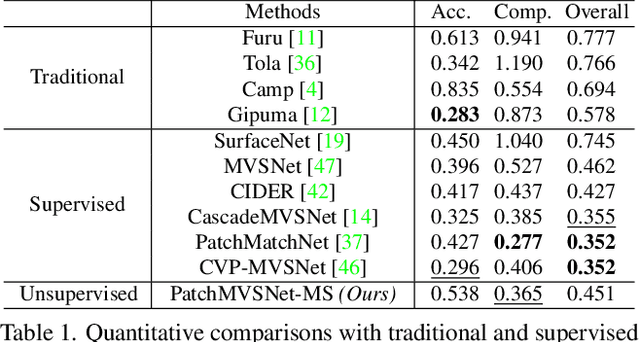
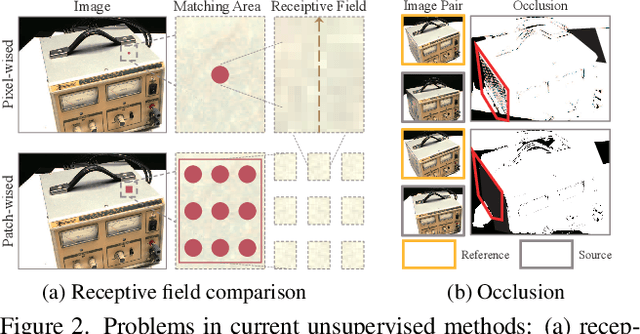

Abstract:Learning-based multi-view stereo (MVS) has gained fine reconstructions on popular datasets. However, supervised learning methods require ground truth for training, which is hard to be collected, especially for the large-scale datasets. Though nowadays unsupervised learning methods have been proposed and have gotten gratifying results, those methods still fail to reconstruct intact results in challenging scenes, such as weakly-textured surfaces, as those methods primarily depend on pixel-wise photometric consistency which is subjected to various illuminations. To alleviate matching ambiguity in those challenging scenes, this paper proposes robust loss functions leveraging constraints beneath multi-view images: 1) Patch-wise photometric consistency loss, which expands the receptive field of the features in multi-view similarity measuring, 2) Robust twoview geometric consistency, which includes a cross-view depth consistency checking with the minimum occlusion. Our unsupervised strategy can be implemented with arbitrary depth estimation frameworks and can be trained with arbitrary large-scale MVS datasets. Experiments show that our method can decrease the matching ambiguity and particularly improve the completeness of weakly-textured reconstruction. Moreover, our method reaches the performance of the state-of-the-art methods on popular benchmarks, like DTU, Tanks and Temples and ETH3D. The code will be released soon.
 Add to Chrome
Add to Chrome Add to Firefox
Add to Firefox Add to Edge
Add to Edge